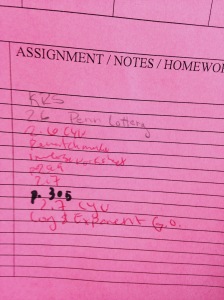Please come prepared to take your exam next week! Please remember to turn in your textbook on the date of the exam as well as all of your Note Cards from the year (a list has been post of all terms). If you are planning on turning in the Math III Exam Study Guide (2015) it is due on the date of your exam. Good luck and enjoy your summer!
Category Archives: Math III
Math III All Noteards
Please remember that ALL note cards for the the entire year, here is the cumulative list for the year:
Unit 1:Bar Graph
Quartile
Outlier
Histogram
Changing Scale
Five Number Summary
Qualitative Data
Quantitative Data
Interquartile Range (IQR)
Median
Pareto Chart
Box and Whiskers
Stem and Leaf
Scatterplot
Matrix
Network
Edge of a Network
Vertex of a Network Matrix Unit 2:
Function
Domain
Range
Function Notation
Linear Function
Absolute Value Function
Cubic Function
Radical Function
Rational Function
Set Notation
Asymptote
Polynomial
Quartic Function
Quintic Function
Vertical Asymptote
Horizontal Asymptote
Piecewise Function
Subfunction
Closed & Open Points
Composite Function
Composite Notation Unit 3:
Hole in a graph
Roots of a Polynomial
Asymptote
Vertical Asymptote
Horizontal Asymptote (Include all rules)
Oblique (Slant) Asymptote
Hole in a graph
Long Division of Polynomial
Synthetic Division of Polynomial Unit 4:
Coordinate Proof
Paragraph Proof
Midpoint Formula
Distance Formula
Slope Formula
Collinear
Coplanar
Postulate
Theorem
Conditional Statement
Counterexample
Converse of Statement
Inverse of Statement
Contrapostive of Statement
Transversal
Corresponding Angles
Corresponding Angles Postulate
Alternate Interior Angles
Alternate Interior Angles Theorem
Same Side Interior Angles
Same Side Interior Angles Theorem
Synthetic Proof
Chord
Tangent
Secant
Perpendicular Bisector
Arc
Circle
Minor Arc
Major Arc
Central Angle
Inscribed Angle
Inscribed Polygon
Angles formed by 2 Tangents
Angles formed by 2 Secants
Angles formed by 2 Chords Unit 5:
Term
Arithmetic Sequence
Recursive Equation for Arithmetic Sequences
Explicit Equation for Arithmetic Sequences
Arithmetic Series
Sum of Finite Arithmetic Series
Sigma Notation
Sequence of Partial Sums
Sum of Finite Arithmetic Series (include equation for calculating it)
Geometric Sequence
Geometric Series
Sum of Finite Geometric Series
Converge
Diverge
Infinite Sequence
Infinite Series
Sum of Infinite Series
Recursive Geometric Sequence Unit 6:
Term
Exponential
Logarithm
Base
Account Balance
Compounding
Continuous Compounding
Natural Exponent
Natural Logarithm
Exponential Growth
Exponential Decay
Exponential Function
Growth Factor
Initial Value of Exponential (or Principal)
Compound Interest Rate
Inverse Function
Depreciate Unit 7:
Probability
Geometric Probability
Combination
Permutation
Simulation
Mutually Exclusive Events
Inclusive Events
Addition Rule for Probability
Complementary Events
Independent Probability
Dependent Probability
Conditional Probability
Binomial Experiment
Probability of Binomial Experiment
Math III Homework 6.8&9.15
Geometric Probability
Combination
Permutation
Simulation
Mutually Exclusive Events
Inclusive Events
Addition Rule for Probability
Complementary Events
Independent Probability
Dependent Probability
Conditional Probability
Binomial Experiment
Probability of Binomial Experiment
Math III Semester 2 Exam Objective List
The following Objectives will be assessed on the Final Exam:
4.1 SWBAT… Use Synthetic, coordinate and paragraph proofs to prove the following theorems and statements
4.2 SWBAT… Prove and Solve for all angles of parallel and perpendicular lines.
4.3 SWBAT… Prove and Solve for all angles of circumscribed and inscribed polygons. (think about the circle things we’ve done)
5.1 SWBAT… Create and apply arithmetic sequences and series to real world problems
5.2 SWBAT… Create and apply gometric sequences and series to real world problems
5.3 SWBAT… Create and apply infinite and finite sequences and series to real world problems
6.1 SWBAT… Solve for any exponential or Natural exponential growth or decay for a real world situation.
6.2 SWBAT… Create and solve for the inverse of any function
6.3 SWBAT… Solve for any Logarithmic or Natural Logarithmic Function for real world situations.
7.1 SWBAT… Use simulations and geometric probability to determine the likelihood of real world occurrences
7.2 SWBAT…Use conditional probability to determine the likelihood of real world occurrences
7.3 SWBAT…Use binomial probability to determine the likelihood of real world occurrences
Math III Homework 5.26&27.15
For next class please complete the Geometric Probability Practice and prepare for your Quiz Thursday/Friday!
Math III Homework 5.11&12.15
For next class please update all objective trackers to reflect all assessments from this year. If you are in need of trackers here is the blank template: Math III Objective Tracker
Math III Homework 5.7&8.15
Test next class!! Please come prepared for your test on Logs, exponents and inverse functions next class.
Here is the Powerpoint we used to work with logarithms during review: exp logs review game
Here’s the binder list:
B Day Homework 4.28.15
For Thursday please complete, from your textbook, p. 303 #3-5, 11-14, 17-20.
Reminder: Quiz Monday
A Day Math III Homework 4.27.15
For Wednesday please complete, from your textbook, p. 303 #3-5, 11-14, 17-20
B Day Math III Homework 3.19.15
For Monday please complete the following note cards and come prepared for you test:
Geometric Sequence
Geometric Series
Sum of Finite Geometric Series
Converge
Diverge
Infinite Sequence
Infinite Series
Sum of Infinite Series
Recursive Geometric Sequence
